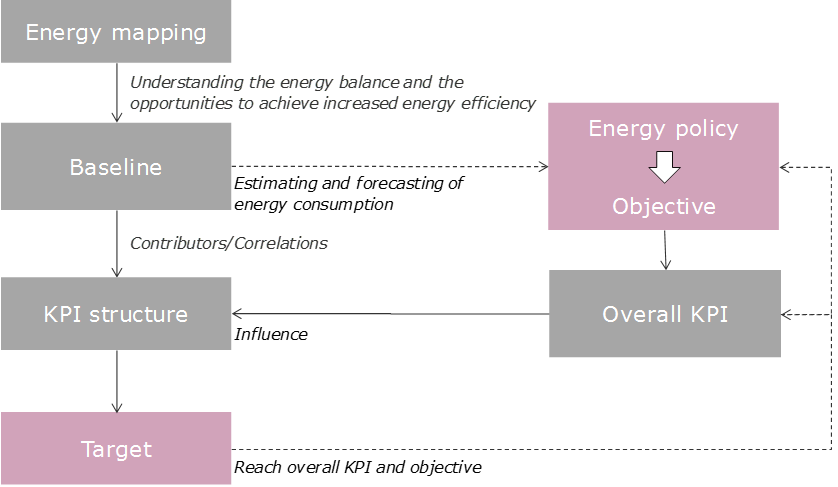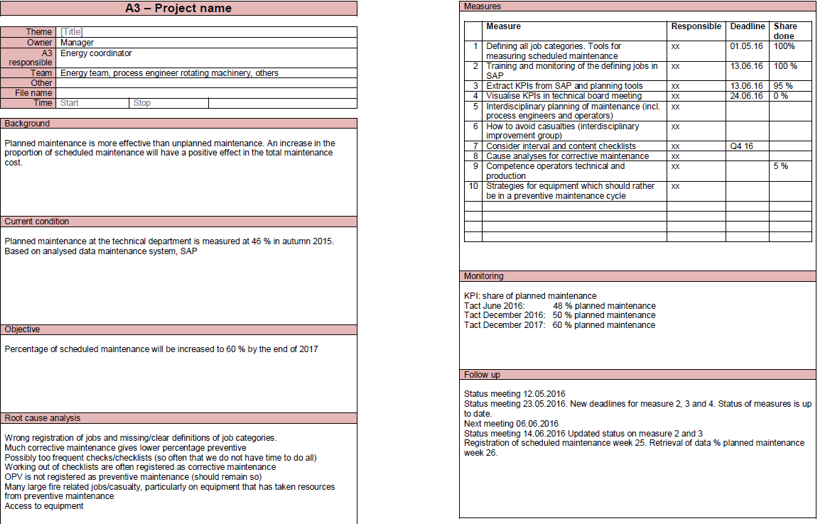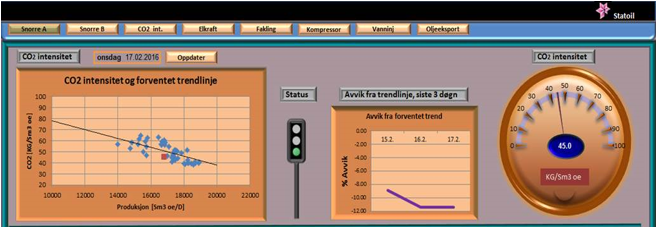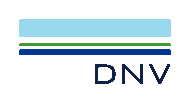After having mapped the energy balance and potentials for improvement, the overall goals and detailed objectives must be established. It is important that your company’s energy policy from top management support the energy objective, and give priority and resources to achieve this objective. An overall energy objective form the foundation of a KPI structure (energy indicators), which is later measured and then monitored continuously.

In the section on establishing baseline you can read more about the relationship between KPIs, baseline and targets and the various terms used to establish these.
Overall energy objectives and targets should be related to each other and be SMART (see below for definition). The way to reach your established objectives and targets is to implement various energy efficiency measures, means and resources. An action plan that includes both planned measures and measures related to non technical activities / campaigns to reach the set energy target and targets to be established.
![]() What should be done
What should be done
As part of the planning phase of an energy management system, the organisation shall do the following:
- Set energy objectives and associated targets.
- Create action plans to achieve the energy efficiency objectives.
Normally, the overall objective is set by management and is related to their energy policy and the company’s general purpose when it comes to energy. The work then consists of setting up a KPI structure and develop action plans for how KPIs and associated targets are to be achieved.
The targets should be defined according to SMART, which is:
- S: Specific, this can for example be energy use per unit produced, to account for variations in the activity level.
- M: Measurable, it should be possible to document them.
- A: Achievable, the targets can be ambitious but should always remain achievable.
- R: Relevant, the targets should be possible to meet by implementing improvement measures.
- T: Time-bound, the targets need to be met within a given timeframe.
It is important that the objectives and associated targets are consistent with the defined energy policy. The targets should be set with the help and input from employees throughout the organisation, and the initiative should come from the top management. It is important to include employees at multiple levels in the organisation to ensure joint ownership of the targets. The targets must be set in accordance with the KPIs as previously defined.
| Konkraft, Klimakur, Roadmap for Norwegian Continental Shelf and industry objectives |
|---|
|
Konkraft is a collaboration arena for the Norwegian oil and gas association (Norsk olje og gass), Norwegian Industries (Norsk Industri), the Norwegian Shipowners' Association (Norges Rederiforbund) and the Norwegian Confederation of Trade Unions (Landsorganisasjonen). Part of the Konfraft mandate is to ensure competitiveness on the Norwegian Continental Shelf (NCS) and attractiveness for development and uptake new technologies. Konkraft published a report in 2009 on the petroleum industry and climate issues where they identified that a reduction potential of 800 000 tonnes of CO2 could be achieved by 2013. The Klimakur 2020 work identified a further reduction potential of 200 000 tonnes of CO2, totalling a reduction potential of 1 million tonnes of CO2 by 2020. Statoil stated that the company will take responsibility for 80% of the identified reduction potential, as it accounts for about 80% of production on the NCS. This initial objective was reached by Statoil in 2015 and has now set new objectives. In 2016, a roadmap was presented for the NCS that discuss value creation and greenhouse gas emissions up to 2030 and 2050. The goal for 2030 is to maintain profitable and safe production at today’s levels, and from 2020 to implement CO2 reduction measures that accumulated are equivalent to 2.5 million tonnes CO2 equivalent per year by 2030. While the goal for 2050 is to maintain Norway’s position as the most important value creator and increase the average recovery rate to at least 60 percent. The NCS shall remain world leading in low CO2 emissions, and the sector will develop and deploy technology solutions that reduce the average CO2 emissions per unit produced significantly, compared with the level in 2030. |
One way to ensure that targets are visible is by addressing them as a topic during morning meetings and other meetings. The targets should be an integral part of existing systems and processes.
The targets may be based on external drivers (such as the Konkraft target on CO2 reductions). It is important to remember setting objectives and targets which employees can influence.
In addition to the targets, an action plan must be implemented and maintained so that the organisation can achieve its objectives and targets.
The action plan should contain:
- Improvement measures and activities to reach the targets and associated deadlines.
- Who is responsible for implementing the improvement measures.
- How to quantify the improvements from the measures and quantify targets to see if energy efficiency improved.
An action plan may have different formats in which one of them is A3. This is not a special process, but a worksheet. (The name comes from the first format that was created in Japan in 1963).
The format of an action plan can include the following:
- Formulating targets
- Organisation, responsibilities
- Indicators of progress
- Resources available
- "S-curve"
- Progress measured by indicators (milestones)
- Use of resources, both human and technical, compared to budget
- Action plan for all necessary measures within a unit or process
- Gantt chart/follow up
- What should be done when, with a deadline for whom
An example of how an A3 worksheet for an action plan can look like is shown below. In addition to the A3 sheet, the action plan should also have a mandate that clearly says who the mandate is for, project manager, internal customer and other details concerning the tool to be used.

![]() Who should be involved
Who should be involved
Employees involved in defining the objectives and targets should be many of the same who were involved in energy mapping (see list below). To ensure management support, more people from higher up in the organisation should also be involved in the process. Finally, it is also important to involve the units that will contribute to reaching the objectives and targets to secure buy in from those people.
Employees with a good knowledge of existing management systems should be included.
People to involve in this phase of the planning could include:
- Management
- Energy Manager
- Director of Operations
- Operations manager
- HSE manager
- Offshore team leader operations (OTLD - Offshore Team Leader Drift)
- Offshore Installation Manager (OIM)
- Responsible for rotating machinery
- Process engineer
- Electrical engineer
- Personnel from drilling
- Other operational personnel
- Project department
- Operators of the relevant processes/equipment
![]() What should be documented
What should be documented
For energy objectives, the following should be documented:
- Documenting energy objectives and associated targets in accordance with legal requirements and other requirements. Sometimes it is sufficient with the documentation you have from follow up at morning meetings.
- Action plan for achieving the objectives for energy efficiency.
![]() Challenges and opportunities
Challenges and opportunities
It is challenging to set objectives and targets that have a good grounding in the organisation, are realistic, yet optimistic and challenging.
It is important to include the right people to establish targets. Therefore, it is recommended that several levels of the organisation are included in the process and in addition, that those persons have the necessary authority for defining the targets.
There are not necessarily easy solutions for all identified challenges. Sometimes, excellent opportunities can arise out of a process like this. For example, it is important to find the right motivation for employees. This can be done by e.g. using cost as an illustrative parameter. This can have a positive impact in terms of savings.
![]() Energy management in practice
Energy management in practice
| Examples of energy management at Statoil |
|---|
|
Statoil has worked extensively with energy management in recent years and is the company on the Norwegian Continental Shelf that have progressed the most. At one of the project's seminars in 2016, Statoil presented the following:
The various examples Statoil presented can downloaded here (only in Norwegian). 
|
Examples from other industries related to setting objectives and targets - you can find more information here. An example from the international oil and gas industry for implementing an energy management system can be found on the same webpage and you can read more about it here.
![]() Where do you find this in ISO 50001?
Where do you find this in ISO 50001?
- Chapter 4.4.6 Energy objectives, targets and energy management action plans

